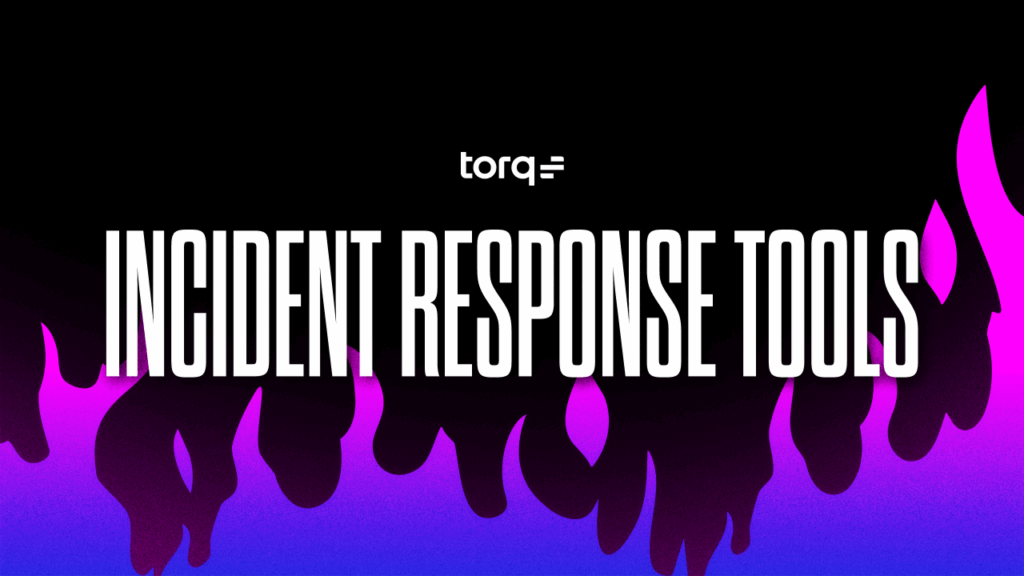Contents
Get a Personalized Demo
See how Torq harnesses AI in your SOC to detect, prioritize, and respond to threats faster.
As cloud complexity explodes and threats move at machine speed, the old security frameworks just don’t cut it — they’re too slow, rigid, and built for a different era.
Today’s security operations demand more: faster action, smarter decisions, and systems that don’t crack under scale. This isn’t just about staying ahead of attackers; it’s about rebuilding the SOC from the ground up, with automation at its core and resilience in its DNA. This is the blueprint for next-gen security operations — and it’s built for today’s threats.
What is a Security Operations Center (SOC) Framework?
A Security Operations Center (SOC) framework outlines the structure, roles, workflows, and technologies required for a team to effectively monitor, detect, investigate, and respond to cybersecurity threats. It ensures consistency, efficiency, and accountability across the SOC’s operations.
The Three Core Components of a SOC Framework
- People: Security analysts, engineers, and managers responsible for triage, investigation, and incident response
- Processes: Standard operating procedures for threat hunting, alert triage, escalation, and remediation
- Technology: Essential tools such as SIEMs, EDR, IDS/IPS, and automation platforms power threat detection and response
Examples of SOC Frameworks
NIST Cybersecurity Framework: Focuses on five core functions — Identify, Protect, Detect, Respond, Recover — to manage cyber risk
MITRE ATT&CK: A detailed matrix of adversary tactics and techniques used to anticipate and understand attacker behavior
Custom frameworks: Many organizations tailor frameworks to their environments, blending industry standards with internal requirements
Benefits of Implementing a SOC Framework
Implementing a structured SOC framework equips security teams with the tools and clarity needed to respond faster, smarter, and more consistently to threats.
- Stronger threat detection: Structured approaches enable proactive identification of emerging threats
- Streamlined incident response: Defined roles and workflows reduce response times and errors
- Reduced risk exposure: Frameworks enforce best practices, minimizing security gaps
- Greater operational efficiency: Standardized processes eliminate ambiguity and improve team performance
Key Considerations for SOC Framework Success
A SOC framework must be practical, adaptable, and deeply aligned with the organization’s operational reality to maximize impact.
- Integration: Frameworks must align with the organization’s broader security ecosystem and tools
- Automation: Automating routine tasks boosts SOC capacity and reduces analyst fatigue
- Continuous improvement: Frameworks should evolve with the threat landscape, incorporating lessons learned and new technologies
Rebuilding the SOC for the Cloud-First Era
The pace of digital transformation has reshaped enterprise infrastructure. Agile development, DevOps, and continuous deployment enable engineering teams to move faster than ever, shipping features in real time, automating updates, and expanding cloud-native environments at scale.
But this speed comes with complexity. Constantly evolving systems introduce new vulnerabilities, while fragmented environments spanning public cloud, on-premises infrastructure, SaaS platforms, APIs, and endpoints create blind spots that traditional security operations centers can’t handle.
Legacy SOC frameworks were built for static environments and perimeter-based defense. They were siloed, reactive, and heavily dependent on manual investigation. Threat detection often lagged behind attacker tactics, and incident response relied on slow, disjointed workflows. As a result, security became a bottleneck instead of a business enabler.
Modern security operations require a fundamentally different approach, one that’s cloud-first, automation-native, and intelligence-driven. A contemporary SOC framework must extend continuous visibility across hybrid cloud infrastructure, integrate seamlessly with CI/CD pipelines and SaaS ecosystems, and adapt to infrastructure changes and new threats in real time. Sophisticated threat actors now leverage automation and AI. To keep up, the SOC must do the same.
Modern SOCs are built for resilience and speed. They function as cross-functional, collaborative teams that leverage AI-powered analytics, automated decision-making, and integrated orchestration so that:
- Alerts are triaged automatically
- Threats are contextualized instantly
- Responses are executed across the stack, from IAM and cloud to endpoint and network, without waiting for human input
The result is a security operations center that moves as fast as the business it protects. By evolving beyond the reactive, manually intensive models of the past, today’s security operations centers become strategic assets, delivering continuous monitoring, proactive threat hunting, and intelligent response at enterprise scale.
Torq’s Role in the Modern SOC: Real Automation for Real-World Demands
Modern SOC frameworks need more than strategy — they need execution. That’s where Torq comes in. Torq enables security teams to build and scale their SOC operations in alignment with today’s demands: speed, resilience, automation, and continuous improvement.
With Torq, security teams can operationalize SOC frameworks through:
- Visual, no-code workflow automation that empowers analysts to orchestrate threat detection, investigation, and response without engineering support.
- Seamless integration with existing SIEM, EDR, cloud security, and IAM tools, ensuring the entire tech stack works together to enforce your framework’s processes.
- Enterprise-grade control and compliance with role-based access, audit logs, and policy enforcement that support governance across global SOC teams.
Torq HyperSOC™ is a fully autonomous security operations platform built for the realities of today’s threat landscape. HyperSOC leverages Hyperautomation and agentic AI to dynamically triage alerts, investigate incidents, and trigger precise remediation, all without human intervention. It automates the key components of your SOC framework: from detection logic and enrichment to playbook execution and case management.
Applying MITRE ATT&CK to Strengthen Detection and Response
MITRE ATT&CK (Adversarial Tactics, Techniques, and Common Knowledge) is a globally recognized, open-source framework that catalogs real-world adversaries’ tactics, techniques, and procedures (TTPs) during cyberattacks. It serves as a behavioral threat model, helping SOC teams and threat intelligence analysts understand how attackers operate.
What it is: Rather than focusing solely on static indicators like IP addresses or file hashes, ATT&CK maps the full attack lifecycle, from initial access and privilege escalation to lateral movement, data exfiltration, and persistence. This enables security teams to build, test, and refine detection and response capabilities that align with how threats unfold in the real world.
How it’s used: Penetration testers and red teams use the framework to emulate adversary behavior and identify weaknesses in infrastructure. Blue teams use it to strengthen defenses by aligning detections and controls to known tactics and techniques, improving visibility, response speed, and resilience.
How it helps: MITRE ATT&CK provides a tactical blueprint of real-world adversary behaviors that SOC analysts can use to improve threat detection and incident response. By mapping alerts and incidents to specific ATT&CK techniques, analysts can identify coverage gaps, refine detection logic, and prioritize high-impact defenses.
Integrating MITRE ATT&CK into SOC workflows enables more proactive threat hunting, more precise response playbooks, and continuous alignment with evolving attacker tactics, strengthening security posture across the entire detection and response lifecycle.
Using MITRE D3FEND to Close Gaps and Validate Controls
MITRE D3FEND is the defensive counterpart to ATT&CK. It maps known tactics to countermeasures, offering prescriptive guidance to reduce attack surfaces and harden systems.
D3FEND empowers SOC teams to implement evidence-based controls, prioritize mitigations, and validate that defenses align with the real tactics adversaries use in the wild.
How Modern SOCs Operationalize MITRE Frameworks
Mature SOCs embed the MITRE ATT&CK and D3FEND frameworks into the fabric of daily operations. These frameworks provide a shared language and strategic lens for identifying detection gaps, simulating adversary behavior, and continuously refining defenses. But their true power is unlocked when paired with Hyperautomation.
With Torq Hyperautomation, SOC teams can:
- Instantly remediate detection gaps identified in ATT&CK
- Automatically update alert logic and enrich incidents based on mapped techniques
- Simulate adversary behavior and validate controls using repeatable, automated workflows
For example, if ATT&CK highlights a missing control for lateral movement, Torq can trigger a sequence to update endpoint detection rules, notify appropriate analysts, and enforce IAM policy adjustments — all automatically.
This transforms the SOC into a self-improving system. One where detection, validation, and response are continuously optimized against evolving threats, and frameworks like MITRE become engines for operational excellence rather than compliance checkboxes.
Beyond automation, leading teams apply ATT&CK and D3FEND for threat modeling and control validation. They simulate realistic attack chains to test how controls hold up under pressure and then harden them based on empirical evidence. Over time, this creates a feedback loop, where detection logic, mitigation tactics, and automated response are continually optimized against evolving threats.
Scaling Smarter: Best Practices for High-Performance SOCs
Modern security operations center frameworks demand more than manual playbooks and reactive processes; they require automation that empowers analysts, accelerates response, and strengthens visibility across every layer of the infrastructure.
With platforms like Torq, SOC analysts can:
- Eliminate alert fatigue and manual triage: Repetitive tasks like threat intel enrichment, investigation, and prioritization overwhelm analysts and delay response. Torq automates these processes by pulling context from SIEM tools, enriching alerts in real time, and routing them based on dynamic risk scoring, accelerating triage, and reducing cognitive load.
- Embed no-code response directly in ChatOps tools: Incident response should happen where collaboration happens. Torq enables teams to execute security workflows natively within Slack, Microsoft Teams, or any ChatOps environment, allowing analysts to act quickly without switching platforms.
- Automate compliance-ready incident documentation: Every step of an incident — from detection through resolution — is automatically logged, timestamped, and auditable. This ensures accurate records for compliance requirements without introducing additional overhead.
But automation alone doesn’t make a SOC resilient. To truly scale operations and mature security programs, organizations must follow best practices for building and evolving their SOC frameworks:
- Align with MITRE ATT&CK, NIST CSF, and CIS Controls: Grounding your SOC framework in well-established standards ensures consistency, auditability, and defensibility. Integrating these frameworks into day-to-day workflows enables adaptive threat detection and informed decision-making.
- Define and track KPIs that matter: Establish performance metrics such as Mean Time to Detect (MTTD), Mean Time to Respond (MTTR), and automation coverage. These indicators provide visibility into operational gaps and inform continuous investment and improvement.
- Scale securely through software, not just headcount: Adding more analysts isn’t always sustainable. Automating Tier-1 triage, orchestrating response workflows, and optimizing alert routing allow SOCs to grow coverage and responsiveness without increasing overhead.
Together, security automation and strategic framework alignment transform the SOC from a reactive, overwhelmed team into a proactive, resilient, and high-performing function that delivers real security outcomes at enterprise scale.
Build a SOC Framework That Adapts as Fast as Threats Do
A modern security operations center framework must do more than meet regulatory standards — it must evolve with your business, your threat landscape, and your technology stack. Frameworks like MITRE ATT&CK, NIST CSF, and CIS provide the strategic foundation. But without automation, those frameworks remain theoretical.
Torq transforms them into action. By automating triage, response, compliance documentation, and control validation, Torq empowers SOC teams to operationalize frameworks in real time, not just for audits, but for actual defense.
Whether you’re scaling globally, modernizing legacy systems, or building your first SOC from scratch, the future of security operations depends on speed, context, and automation. Don’t settle for reactive checklists. Build an autonomous SOC that’s intelligent, resilient, and engineered to thrive in today’s threat environment.
Want to see how AI-driven Hyperautomation can modernize your SOC? Get the manifesto.






